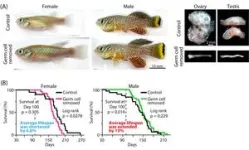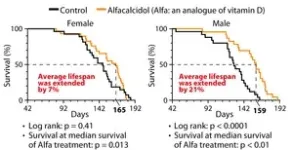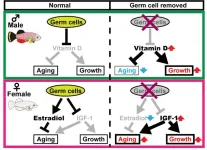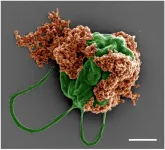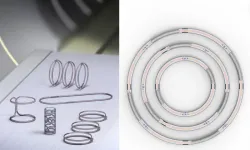(Press-News.org) Including “tactile emoticons” into social media communications can enhance communication, according to a study published June 12, 2024 in the open-access journal PLOS ONE by Alkistis Saramandi and Yee Ki Au from University College London, United Kingdom, and colleagues.
Digital communications rely exclusively on visual and auditory cues (text, emoticons, videos, and music) to convey tone and emotion. Currently lacking from these platforms is touch, which can convey feelings of love and support, impact emotions, and influence behaviors. Technology companies are developing devices to incorporate touch into digital interactions, such as interactive kiss and hug transmission devices. These social touch devices can elicit feelings of closeness and positive emotions, but the effect of touch in social media communication is not well studied.
In this study, researchers incorporated tactile emoticons into social media interactions. Using a mock social media platform, participants were given posts to send that expressed either positive or negative emotions. They then received feedback via visual emoticons (e.g., a heart or thumbs up), tactile emoticons (a stroke on the forearm by either another person or a robotic device), or both.
Participants felt greater feelings of support and approval when they received the tactile emoticons compared to the visual-only feedback. This suggests that social touch, even by a stranger, can convey meaning without any other accompanying communication. Feedback consisting of both visual and tactile emoticons was preferred over either type of emoticon alone. The researchers noted that touch could offer additional context to visual emoticons, which can be misinterpreted. They also found that the type of touch matters. Touch delivered at a speed that activates the C-Tactile nervous system, which produces positive emotions associated with touching or embracing, was experienced more favorably than other types of touch.
According to the authors, this is the first study to explore the role of touch in communicating emotions via social media. They hope that the results can inform the development of devices to deliver touch during digital communications.
The authors add: “Touch has long been essential to human bonding and survival, yet in our digitized world we are more isolated and touch-deprived than ever. What if we could use 'digitalized touch' to bring us closer in communicating emotions in today's world?”
#####
In your coverage please use this URL to provide access to the freely available article in PLOS ONE: https://journals.plos.org/plosone/article?id=10.1371/journal.pone.0304417
Citation: Saramandi A, Au YK, Koukoutsakis A, Zheng CY, Godwin A, Bianchi-Berthouze N, et al. (2024) Tactile emoticons: Conveying social emotions and intentions with manual and robotic tactile feedback during social media communications. PLoS ONE 19(6): e0304417. https://doi.org/10.1371/journal.pone.0304417
Author Countries: UK, Sweden, Australia
Funding: This work was undertaken with funding from the UCL Social Science+ award (to CJ, NB and AF; https://www.ucl.ac.uk/research/domains/collaborative-social-science/research/social-science-plus), and in part with funding from the European Research Council (ERC) Starting Grant ERC-2012-STG GA313755 (to AF; https://erc.europa.eu/apply-grant/starting-grant), and the European Union’s Horizon 2020 research and innovation programme under grant agreement No. 818070, for the Consolidator Award METABODY (to AF; https://erc.europa.eu/apply-grant/consolidator-grant). The funders had no role in study design, data collection and analysis, decision to publish, or preparation of the manuscript.
END
Incorporating “touch” into social media interactions can increase feelings of support and approval
Responses to social media posts that included both visual and tactile feedback were most effective
2024-06-12
ELSE PRESS RELEASES FROM THIS DATE:
The gender gap in life expectancy: are eggs and sperm partly responsible?
2024-06-12
Osaka, Japan – Women live longer than men. This isn’t unique to humans, either; we see this trend in a wide range of other animals. Biologists have theorized that the discrepancy in life expectancy between sexes might be partly related to reproduction, but how?
In a study published in Science Advances, researchers from Osaka University have discovered for the first time that germ cells, the cells that develop into eggs in females and sperm in males, drive sex-dependent lifespan differences in vertebrate animals.
The researchers ...
Swimming microrobots deliver cancer-fighting drugs to metastatic lung tumors in mice
2024-06-12
Engineers at the University of California San Diego have developed microscopic robots, known as microrobots, capable of swimming through the lungs to deliver cancer-fighting medication directly to metastatic tumors. This approach has shown promise in mice, where it inhibited the growth and spread of tumors that had metastasized to the lungs, thereby boosting survival rates compared to control treatments.
The findings are detailed in a paper published on June 12 in Science Advances.
The microrobots are an ingenious combination of biology ...
Ambivalence + polarized views can promote political violence
2024-06-12
COLUMBUS, Ohio – Feeling ambivalent about a political issue might seem to be a recipe for indecision and even inaction.
But a new study suggests, surprisingly, that ambivalence can actually lead some people –especially those with polarized views – to be more supportive of extreme actions, such as violence.
The reason? Researchers found that ambivalence creates discomfort in those with extreme views by making them feel weak or insecure about their beliefs – and that can lead them to compensate for that weakness by supporting extreme actions to signal strength.
“When people have ...
Unleashing the power of metamaterials to improve MRI imaging
2024-06-12
In recent years, the field of metamaterials has experienced substantial growth, revealing exciting potential, especially in advancing magnetic resonance imaging (MRI) technology. Three new studies led by Dr. Xin Zhang, a BU College of Engineering Distinguished Professor and a professor at the BU Photonics Center, highlight the promising opportunities within this field. These studies, in collaboration with Dr. Stephan Anderson, a BU Chobanian & Avedisian School of Medicine professor of radiology, published in Advanced Science, Advanced Materials, and Science Advances, showcase innovative approaches to enhance the MRI experience for all patients. ...
USC EdTech Accelerator collaborates with Intel
2024-06-12
USC Rossier Education Technology Accelerator (USC EdTech Accelerator) announced a unique collaboration with Intel Corporation focused on supporting the use of technology for learning with a particular emphasis on supporting marginalized communities and AI.
The Partnership
The USC EdTech collaboration with Intel will provide free educational and technical assistance to learning-focused start-ups to increase the likelihood that they design viable, efficacious and scalable AI-enhanced solutions for learners. “We believe ...
What is the neural mechanism behind helping someone at your own cost?
2024-06-12
Using a unique setup, researchers from the Social Brain Lab at the Netherlands Institute for Neuroscience have researched the neural mechanism behind a universal dilemma: deciding whether to help someone else even when it involves a personal sacrifice.
We often have opportunities to give up something we care about to help others. What brain mechanisms help us make those decisions, and why do some people help more than others?
Over the years, philosophers and scientists have suggested that the extent to which a person empathizes with the distress of others influences their willingness to help.
To explore this hypothesis experimentally, Kalliopi ...
Can we withdraw treatment in post-menopausal osteoporosis?
2024-06-12
Osteoporosis is characterised by low bone mineral density and bone fragility.5 During menopause, falling oestrogen levels impair normal bone turnover, with an average reduction in bone mineral density of 10%.5 This is compounded by the age-related bone loss that occurs in both men and women. With an ageing population, post-menopausal osteoporosis represents a growing health problem.
These new data are from a case-control cohort study of over 128,000 women included in the French national claim database. The main aim was to estimate the incidence of long-term discontinuation of bisphosphonates – ...
Vexas: towards molecular and phenotypic characterization
2024-06-12
VEXAS is characterised by predominantly rheumatic and haematologic systemic involvement, and caused by somatic mutation in UBA1 – a gene encoding ubiquitin-activating enzyme 1,1,2 which is necessary for a post-translation modification that affects protein functions ranging from degradation to subcellular localisation and kinase activation.3 The syndrome was first described in 2020, but diagnosis can be challenging as the symptoms overlap with many other inflammatory conditions.1 Hot on the heels of this recent discovery, research is underway to better understand pathogenesis, clinical features, and potential treatment options.1
To support this, ...
Location, location, location – does it matter in psoriatic arthritis?
2024-06-12
Arthritis affects various joints differently, despite systemic inflammatory cues.2 In people with rheumatoid arthritis, transcriptomic variances identified in synovial fibroblasts from various joint sites have been shown to translate into joint-specific phenotypes with distinct characteristics and responsiveness to cytokines.2,3 These findings suggest that different joints may potentially respond variably to specific immunosuppressive treatments. To expand on this, Ciurea and colleagues set out to investigate whether joints at different anatomical locations in people with PsA might respond differently to treatment with a tumour necrosis ...
Stopping the march
2024-06-12
The estimated prevalence of psoriatic arthritis (PsA) in people with psoriasis ranges widely –between 6% and 42% – but in most cases, skin symptoms precede PsA, thus making skin psoriasis a model for pre-PsA.2 Assuming that there are shared pathways in the pathogenesis, it is possible that stringent treatment of moderate-to-severe psoriasis could reduce progression to clinically overt PsA.3,4 Biologic treatments are effective at controlling psoriasis, but there are no conclusive data that these treatments help prevent people from developing PsA. Several risk factors for transition have previously been identified by a EULAR taskforce.5 ...
LAST 30 PRESS RELEASES:
Australian team discover why quantum computers have memory problems over time
What determines the fate of a T cell?
Candida auris: genetic process revealed which could be treatment target for deadly fungal disease
Groundbreaking discovery turns household plastic recycling into anti-cancer medication
Blocking a key inflammatory pathway improves liver structure and vascular function in cirrhosis, study finds
Continuous spread: Raccoon roundworm detected in nine European countries
HKUST Engineering researchers developed a novel photodetector to enhance the performance of on-chip light monitoring
Strategic river sensors could have forewarned of Texas Camp flood disaster
Drone sampling of whale breath reveals first evidence of potentially deadly virus in Arctic
Roman soldiers defending Hadrian’s Wall infected by parasites, study finds
Pinochet’s prisoners were tormented with music but still found solace in it, a new book reveals
Fertility remains high in rural Tanzania despite access to family planning
AI-assisted device can improve autism care access
Kinetic careers
Uncovering how parasitic plants avoid attacking themselves to improve crop resistance
Nanoparticle vaccine strategy could protect against Ebola and other deadly filoviruses
Study finds brain care score can predict risk of stroke across racial groups
Key lung immune cells can intensify allergic reactions
Do hormones explain why women experience more gut pain?
New materials conduct ions in solids as easily as in liquids
Breakthrough of the Year: Renewable energy begins to eclipse fossil fuel-based sources
LLM use is reshaping scientific enterprise by increasing output, reducing quality and more
Introducing LightGen, a chip for ultra-fast, ultra-efficient generative AI
Astronomers see fireworks from violent collisions around nearby star
ACC/AHA issue new guideline on managing congenital heart disease in adults
Cosmic crash caught on camera
Is talented youth nurtured the wrong way? New study shows: top performers develop differently than assumed
Ants: An untapped resource in the development of antibiotics?
Archaeologists use AI to create prehistoric video game
Mitochondria migrate toward the cell membrane in response to high glucose levels
[Press-News.org] Incorporating “touch” into social media interactions can increase feelings of support and approvalResponses to social media posts that included both visual and tactile feedback were most effective

